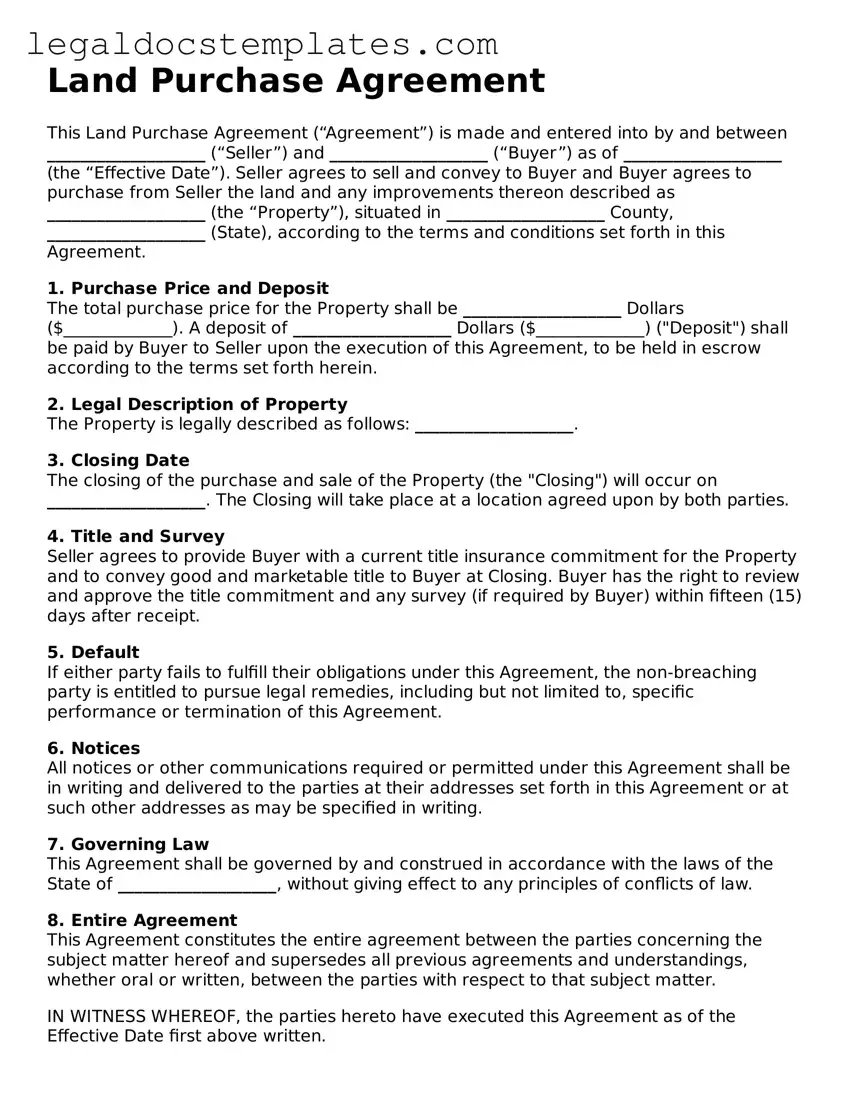The Real Estate Purchase Agreement shares a close similarity with the Land Purchase Agreement, as both serve to establish the terms and conditions under which a property transaction occurs. This document outlines the specifics of the sale, including the purchase price, financing terms, and any contingencies that might affect the completion of the sale, much like its land-focused counterpart. However, it broadens its scope to include not just land but also any structures on the property.
A Quitclaim Deed, although differing in function, shares a conceptual proximity to a Land Purchase Agreement. It is used to transfer any ownership interest a person might have in a piece of property to another person, without guaranteeing that the ownership is free and clear of claims. This document complements the purchase agreement by clarifying the title and ownership status post-transaction, effectively serving to finalize the transfer initiated by the sale.
The Warranty Deed is akin to the Land Purchase Agreement in its role in property transactions, offering more protection than a Quitclaim Deed. It not only transfers ownership from one party to another but also guarantees that the seller holds clear title to the property. This document parallels the assurances provided in a typical Land Purchase Agreement, ensuring the buyer receives the property without any liens, disputes, or encumbrances.
Lease Agreements, while primarily focused on the rental rather than the purchase of property, share the contractual nature of Land Purchase Agreements. They outline the terms under which one party agrees to rent property from another party, including duration, payment, and use parameters. These documents are similar in their detailed structuring of an agreement concerning the use of land or property, differing mainly in the permanence of the arrangement.
The Property Deed is an essential document in property transactions, directly related to the Land Purchase Agreement. It represents the official transfer of property from the seller to the buyer, a process initiated by the agreement of sale. While the Land Purchase Agreement specifies the terms of the sale, the Property Deed conclusively establishes ownership, serving as the legal evidence of the transfer.
Loan Agreements entwine closely with the financial aspects of a Land Purchase Agreement. When purchasing land, buyers often require financing, which is detailed in a separate loan agreement with a lender. This document outlines the terms of the loan, including interest rate, repayment schedule, and collateral – in many cases, the property itself. While serving different functions, both documents are pivotal in the acquisition process, delineating the financial commitments involved.
An Option Agreement presents a unique similarity to the Land Purchase Agreement. It gives one party the option to purchase property at a predetermined price within a specified timeframe, without the obligation to buy. Similar to a purchase agreement, it outlines specific conditions and considerations for the transaction. However, it maintains flexibility, primarily serving buyers not yet ready to commit to a purchase.
Home Inspection Reports, though not contractual documents, play a critical supporting role in the process outlined by a Land Purchase Agreement. These reports provide an in-depth examination of the property's condition, informing the buyer and potentially affecting negotiation terms within the agreement. The inspection can lead to adjustments in the sale terms based on the findings, directly impacting the implementation of the purchase agreement.
The Title Insurance Policy stands as a risk mitigation document closely connected to the assurances sought through a Land Purchase Agreement. It protects the buyer (and lender) from future claims against the property's title, such as disputes over ownership or issues with prior liens. By confirming the title's validity, this policy complements the purchase agreement's aim to ensure a clean and undisputed transfer of property.
Lastly, the Escrow Agreement, often a part of larger property transactions, tangentially relates to the Land Purchase Agreement. It involves a third party holding assets on behalf of the buyer and seller until specified conditions, detailed in the purchase agreement, are met. This document ensures that neither party prematurely benefits from the transaction without fulfilling their agreed-upon obligations, thereby securing a level of trust and compliance in the transaction process.
